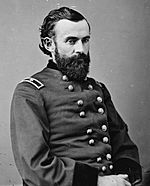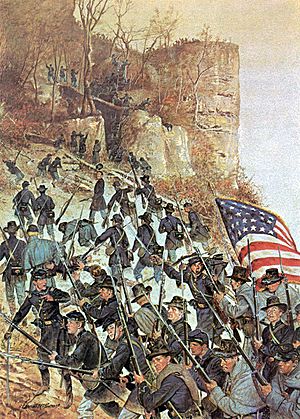6th Wisconsin Infantry Regiment facts for kids
Quick facts for kids 6th Wisconsin Infantry Regiment |
|
|---|---|

|
|
| Active | July 16, 1861 – July 2, 1865 |
| Country | United States |
| Allegiance | Union |
| Branch | Infantry |
| Size | Regiment |
| Engagements | American Civil War |
| Commanders | |
| Colonel | Lysander Cutler |
| Colonel | Edward S. Bragg |
| Colonel | Rufus Dawes |
| Colonel | John Azor Kellogg |
The 6th Wisconsin Infantry Regiment was an infantry regiment that served in the Union Army during the American Civil War. It spent most of the war as a part of the famous Iron Brigade in the Army of the Potomac.
Service
The 6th Wisconsin was raised at Madison, Wisconsin, and mustered into Federal service July 16, 1861, for a term of three years. It saw severe fighting in the 1862 Northern Virginia Campaign, fighting at Brawner's Farm during the early part of the Second Battle of Bull Run. During the subsequent Maryland Campaign, the 6th attacked Turner's Gap in the Battle of South Mountain, and then suffered considerable casualties battling Hood's Texas Brigade in the D.R. Miller cornfield at Antietam.
During the first day of the Battle of Gettysburg on July 1, 1863, Lt. Col. Rufus R. Dawes led a counterattack on Joseph R. Davis's Confederate brigade of Mississippians, many of which were sheltered in an unfinished railroad cut west of town. The 6th forced the surrender of over 200 enemy soldiers. The regiment later served that year in the Bristoe and Mine Run Campaigns.
The regiment participated in the Grand Review of the Armies on May 23, 1865, and then mustered out at Louisville, Kentucky, on July 2, 1865.
Total enlistments and casualties
The 6th Wisconsin Infantry initially mustered 1,029 men and later recruited an additional 601 men, for a total of 1,630 men. The regiment lost 16 officers and 228 enlisted men killed in action or who later died of their wounds, plus another 1 officer and 112 enlisted men who died of disease, for a total of 357 fatalities.
Commanders

- Colonel Lysander Cutler (May 28, 1861 – November 29, 1862) was promoted to brigadier general, commanded the Iron Brigade. He served through nearly the entire war and received an honorary brevet to major general.
- Colonel Edward S. Bragg (March 10, 1863 – June 25, 1864) began the war as captain of Co. E. He was later promoted to brigadier general and commanded the Iron Brigade. After the war he became a U.S. congressman and U.S. minister to Mexico.
- Colonel Rufus Dawes (July 5, 1864 – August 9, 1864) began the war as captain of Co. K, and was acting commander of the regiment at the Battle of Gettysburg. He mustered out at the end of his three-year enlistment and received an honorary brevet to brigadier general. After the war, he served as a U.S. congressman and wrote an extensive memoir of his Civil War service. His son, Charles G. Dawes, was the 30th vice president of the United States.
- Colonel John Azor Kellogg (December 10, 1864 – July 14, 1865) began the war as 1st lieutenant of Co. K, and served as adjutant to the brigade commander in 1863 and was a prisoner of war for several months in 1864. He mustered out with the regiment at the end of the war and received an honorary brevet to brigadier general. After the war, he served in the Wisconsin State Senate and wrote a memoir of his time as a prisoner of war.
Notable people
- Oscar Bartlett, assistant surgeon, later became chief surgeon for the 3rd Wisconsin Infantry Regiment. Resigned due to disability. Before the war, he had served in the Wisconsin Legislature.
- Francis A. Deleglise was a corporal in Co. E and was wounded at Antietam and Gettysburg. After the war he served as a Wisconsin state legislator and was a founder of Antigo, Wisconsin.
- Daniel J. Dill, captain of Co. B, later became colonel of the 30th Wisconsin Infantry Regiment. After the war served as a Wisconsin state legislator.
- John C. Hall, chief surgeon, later served as a Wisconsin state senator.
- Frank A. Haskell, adjutant, became adjutant and staff aide to General John Gibbon, later commissioned colonel of the 36th Wisconsin Infantry Regiment, killed in action at Cold Harbor.
- John J. Jenkins was a private in Co. A. Later in life, he became a seven-term U.S. congressman and a federal judge.
- Robert Lees, private in Co. H, later became first sergeant, wounded at Gettysburg. After the war served as a Wisconsin state senator and county judge.
- James R. Lyon, initially managed a supply wagon, later became a private in Co. I. After the war served as a Wisconsin state legislator.
- Adam Gale Malloy, captain of Co. A, later became colonel of the 17th Wisconsin Infantry Regiment and received an honorary brevet to brigadier general.
- George Davis McDill, private and corporal in Co. I, later became captain of Co. K in the 37th Wisconsin Infantry Regiment. After the war served as a Wisconsin state legislator.
- Albert T. Morgan was captain of Co. H near the end of the war. He previously served as captain of Co. B in the "independent battalion" remnant of the 2nd Wisconsin Infantry Regiment, which was absorbed into the 6th Wisconsin Infantry in November 1864. He received a double-honorary brevet to lieutenant colonel at the end of the war. After the war, he was a Mississippi state senator and wrote a memoir of his experiences in the reconstruction-era south.
- David K. Noyes, first lieutenant and captain in Co. A, severely wounded at Antietam. Later served as lieutenant colonel of the 49th Wisconsin Infantry Regiment. After the war served as a postmaster and newspaper publisher.
- Peter Polin was 2nd lieutenant in Co. H, but resigned before the regiment left Wisconsin. He elected posthumously to the Wisconsin Assembly in 1870, having died the day before the election.
- John Starks, sergeant in Co. A, was the son of Argalus Starks. He was badly wounded at Gainesville, later commissioned captain of Co. K, 23rd Wisconsin Infantry Regiment, and was mortally wounded at Vicksburg.
- Benjamin Sweet, major and lieutenant colonel, later served as colonel of the 21st Wisconsin Infantry Regiment and was badly wounded and disabled at Perryville. Given command of the prisoner-of-war camp Camp Douglas. After the war, received an honorary brevet to brigadier general.
- John Tester, first lieutenant of Co. H, later served as a Wisconsin state legislator.
- Francis A. Wallar was corporal, sergeant, and later 2nd lieutenant in Company I. He was awarded the Medal of Honor for actions at Gettysburg. After the war he was sheriff of Vernon County, Wisconsin.
- Jerome Anthony Watrous, private and sergeant in Co. E, commissioned as adjutant of the regiment and received an honorary brevet to captain. After the war served as a Wisconsin state legislator and historian, and served as a U.S. Army officer in the Spanish–American War.






